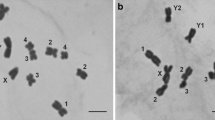Abstract
The mammalian Y-linked sex determining gene, SRY (Sex determining region Y), encodes a protein with a DNA-binding domain, HMG box. In a wide variety of animal species, a large family of genes containing this highly homologous HMG box, which has been named Sox (SRY-related HMG box), have been identified. Several Sox genes have already been shown to be transcription factors involved in development. In the present study, using primed in situ labelling (PRINS), we report the chromosome mapping of two Sox genes in rice field eel Monopterus albus. The Sox9 gene was mapped to chromosome 6 at a position of 52.03% of the distance from the centromere, while the Sox17 gene was assigned to chromosome 5 on the region of 20.17% from centromere.
Similar content being viewed by others
References
Cremazy, F., Soullier, S., Berta, P. and Jay, P. 1998. Further complexity of the human Sox gene family revealed by the combined use of highly degenerate primers and nested PCR. FEBS Letters 438, 311–314.
De Santa Barbara, P., Bonneaud, N., Boizet, B., Desclozeaux, M., Moniot, B., Südbeck, P., Scherer, G., Poulat, F. and Berta, P. 1998. Direct interaction of SRY-related protein SOX9 and steroidogenic factor 1 regulates transcription of the human anti-mullerian hormone gene. Molecular and Cellular Biology 18, 6653–6665.
Foster, J.W., Dominguez-Steglich, M.A., Guioli, S., Kwok, C., Weller, P.A., Stevanovic, M., Weissenbach, J., Mansour, S., Yong, I.D., Goodfellow, P.N., Brook, J.D. and Schafer, A.J. 1994. Campomelic dysplasia and autosomal sex reversal caused by mutations in an SRY-related gene. Nature 372, 524–530.
Hudson, C., Clements, D., Friday, K.V., Stott, D. and Woodland, H.R. 1997. Xsox17 alpha and beta mediate endoderm formation in Xenopus. Cell 91, 397–405.
Kanai, Y., Kanai-Azuma, M., Noce, T., Saido, T.C., Shiroishi, T., Hayashi, Y. and Yazaki, K. 1996. Identification of two Sox17 messenger KNA isoforms, with and without the high mobility group box region, and their differential expression in mouse spermatogenesis. Journal of Cell Biology 133, 667–681.
Lahbib-Mansais, Y., Barbosa, A., Yerle, M., Parma, P., Milan, D., Pailhoux, E., Gellin, J. and Cotinot, C. 1997. Mapping in pig of genes involved in sexual differentiation: AMH, WT1, FTZF1, SOX2, SOX9, AHC, and placental and embryonic CYP19. Cytogenetics and Cell Genetics 76, 109–114.
Morais da Silva, S., Hacker, A., Harley, V., Goodfellow, P., Swain, A. and Lovell-Badge, R. 1996. Sox9 expression during gonadal development implies a conserved role for the gene in testis differentiation in mammals and birds. Nature Genetics 14, 62–68.
Spotila, L.D., Spotila, J.R. and Hall, S.E. 1998. Sequence and expression analysis of WTI and Sox9 in the red-eared slider turtle, Trachemys scripta. Journal of Experimental Zoology 281, 417–427.
Südbeck, P., Schmitz, M.L., Baeuerle, P.A. and Scherer, G. 1996. Sex reversal by loss of the C-terminal transactivation domain of human SOX9. Nature Genetics 13, 230–232.
Takamatsu, N., Kanda, H., Ito, M., Yamashita, A., Yamashita, S. and Shiba, T. 1997. Rainbow trout Sox9: cDNA cloning, gene structure and expression. Gene 202, 167–170.
Wagner, T., Wirth, J., Meyer, J., Zabel, B., Held, M., Zimmer, J., Pasantes, J., Bricarelli, F., Keutel, J., Hustert, E., Woif, U., Tommerup, N. and Schempp, W. 1994. Autosomal sex reversal and campomelic dysplasia are caused by mutations in and around the SRY-related gene SOX9. Cell 79, 1111–1120.
Wright, E., Hargrave, M.R., Christiansen, J., Cooper, L., Kun, J., Evans, T., Gangadharan, U., Greenfield, A. and Koopman, P. 1995. The Sry-related gene Sox9 is expressed during chondrogenesis in mouse embryos. Nature Genetics 9, 15–20.
Young, I.D., Zuccollo, J.M., Maltby, E.L. and Broderick, N.J. 1992. Campomelic dyplasia associate with a de novo 2q: 17q reciprocal translocation. Journal of Medical Genetics 29, 251–252.
Yu, X., Zhou, T., Li, Y., Li, K. and Zhou, M. 1989. Chromosomes of Chinese Freshwater Fish. Science Press, Beijing, pp. 140–143.
Author information
Authors and Affiliations
Rights and permissions
About this article
Cite this article
Huang, X., Zhou, R., Liu, L. et al. Chromosome assignments of the rice field eel Sox9 and Sox17 genes. Aquaculture International 7, 393–397 (2000). https://doi.org/10.1023/A:1009230814535
Issue Date:
DOI: https://doi.org/10.1023/A:1009230814535




